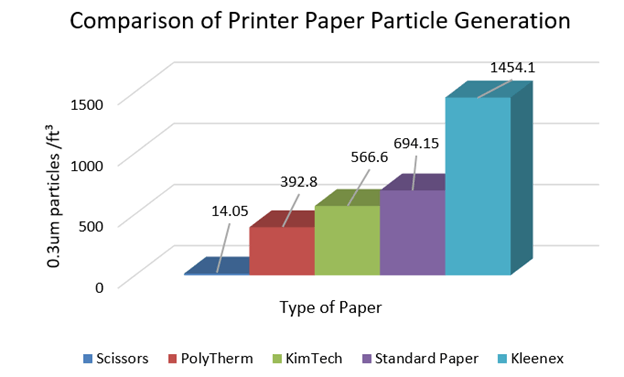What Is Cleanroom Paper? [Case Study]
Do you use print-outs in your cleanroom? What kind of paper do you use? Could we be doing better than current industry standards? We think so. This is why we’ve started to investigate “cleanroom paper” and how this paper can impact the number of particles in a cleanroom while making your life easier.
This cleanroom paper is actually polythermal paper, which is the same kind of paper that many receipts are made out of. But we wanted to know if it would be better for use in cleanrooms than standard printer paper.
So we put them to the test!
 Testing Methods For Cleanroom Paper
Testing Methods For Cleanroom Paper
For best practices, we tested Kleenex, standard printer paper, and cleanroom paper with KimTech wipes as the control for particle shedding. We secured the papers perpendicular to the sampling ISO kinetic probe connected to the Apex Z3 (ISO 17025 accredited) to monitor the papers for particle emissions.
We sheared each paper using Westcott titanium scissors under a controlled HEPA flow hood to see how many particles they generated. We collected an average of 16 samples for each paper selection.
So what did we find?

We found, on average, the cleanroom paper let out even fewer particles than KimTech wipes. It produced half as many particles as its counterpart: standard printer paper. Depending on your cleaning practices and procedures, we recommend polythermal “cleanroom” paper as an alternative to standard printer paper in an endeavor to keep your cleanroom clean.
 Why Does It Matter?
Why Does It Matter?
We go through all kinds of procedures when we go into a cleanroom. We gown up, we clean everything, we go through decontamination processes… But too often, we forget that every little detail in a cleanroom matters. Including the paper we use when we’re taking notes or printing on.
It feels like an oxymoron, but even the cleaning tools we bring into the cleanroom can shed particles.
In fact, humans alone account for 75% to 85% of particles shed in a cleanroom. We shed somewhere around 40,000 skin cells every minute.
We generate around 100,000 particles of 0.3 microns or larger through our skin, hair, clothing, and more when we are stationary.
But what about when we’re moving? That number increases to over 5,000,000 particles.
This is just accounting for humans. Not everything we bring into a cleanroom.
So even with all the precautions, it’s critical we pay extra attention to small details so we can avoid shedding even more millions of particles in the cleanroom.
That’s why we offer particle counters that have wireless and paperless options, so that’s just one less piece of equipment going in and out of the room!
 What Other Ways Can You Keep Your Cleanroom Cleaner?
What Other Ways Can You Keep Your Cleanroom Cleaner?
Now that we are talking about details you can work on to maximize your cleanroom, we do have some suggestions!
We always recommend double-checking and re-training on gowning procedures to help reduce the number of particles shed by humans. If your gowning procedure is not optimized, even a small patch of skin on someone’s wrist can result in millions of particles being shed.
We also recommend switching to wireless options in the cleanroom wherever possible. While this might require charging equipment, it reduces the amount of equipment necessary in a cleanroom. You can replace a 10-foot long cord with a much smaller charging port.
Speaking of equipment, when was the last time you checked your cleaning procedures for equipment entering and exiting the cleanroom? Ideally, all equipment stays in the cleanroom, but practically, we know some items go in and out of the cleanroom. So make sure to check what your current protocols are and potentially re-train on them.
Beyond your cleaning procedures, are you checking on the equipment doing the cleaning for you? For instance, in a NASA facility, they let one of their filters go 40 years without being replaced. So, in 2018, one of the cleanrooms was contaminated with fungus. Since fungus can spread so rapidly, this was highly concerning. They ended up contaminating samples and losing research over this lapse. So we highly recommend doing regular maintenance and checks on your equipment.
But we also always recommend investing in equipment that will help you keep your cleanroom clean. If your equipment is not working for you, it can be working against you.
 Let Us Help You Keep Your Cleanroom Clean!
Let Us Help You Keep Your Cleanroom Clean!
As the world’s experts on clean air, we are dedicated to making sure your cleanroom stays as clean as possible – down to the paper you use!
We understand that extra particles in your cleanroom can delay production, cause yield loss, and potentially hurt the reputation of your business among a myriad of potential repercussions. So we’re determined to help you monitor your cleanroom to mitigate losses and improve workflow.
Using state-of-the-art technology, we set industry standards. To start, we brought real-time monitoring technology to the market, so you can know instantly if your classroom is contaminated. And now we’ve combined that technology with user- and cleanroom-friendly tools to make your life easier.
Our particle counters have wireless, paperless options and are ergonomically friendly. Not to mention, we have the fastest recharge time and longest battery life on the market, so you can check that off your to-do list.
As clean air experts, we know that cleanrooms need to be clean. And we want to take that off your plate, so you can focus on the big picture. Want to know if one of our particle counters is right for you? Find out today.


